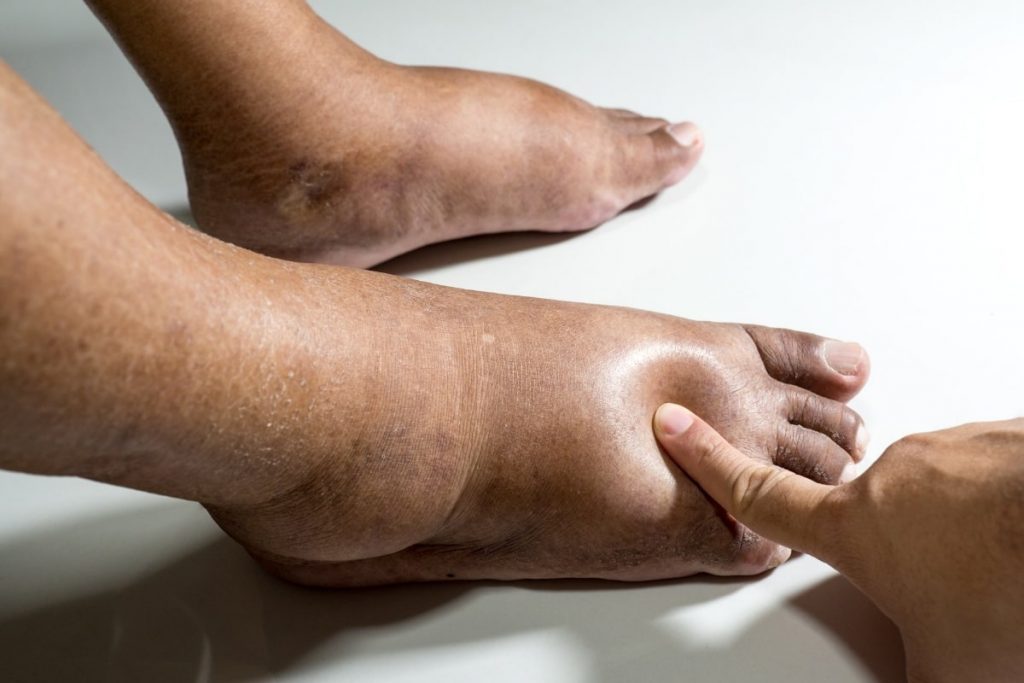Edema, medically referred to as fluid retention, is characterized by the accumulation of excess fluid in the body’s tissues, leading to swelling. This condition can affect various parts of the body, including the limbs, lungs, and other organs. Understanding the underlying causes, recognizing the symptoms, and implementing appropriate management strategies are crucial for effective treatment.

What is Edema?
Its manifests as swelling resulting from fluid accumulation in the interstitial spaces of tissues. It can be localized, affecting specific areas such as the feet, ankles, or hands, or generalized, impacting multiple regions simultaneously. The severity and underlying causes of edema vary, necessitating a comprehensive approach to diagnosis and treatment.
Common Causes of Edema
Several factors can contribute to the development of edema:
- Heart Failure: The heart’s inability to pump blood effectively can lead to fluid buildup, particularly in the lower extremities.
- Kidney Disease: Impaired kidney function can result in sodium and fluid retention, causing systemic swelling.
- Liver Cirrhosis: Liver scarring can disrupt blood flow, leading to fluid accumulation in the abdomen and legs.
- Venous Insufficiency: Damaged veins, especially in the legs, can impede blood return to the heart, causing pooling and swelling.
- Medications: Certain drugs, including antihypertensives, nonsteroidal anti-inflammatory drugs (NSAIDs), and corticosteroids, may cause fluid retention as a side effect.
- Pregnancy: Hormonal changes and increased blood volume during pregnancy can lead to swelling, particularly in the lower limbs.
Recognizing the Symptoms
The presentation of edema can vary based on its underlying cause and severity. Common symptoms include:
- Swelling: Noticeable puffiness under the skin, especially in the legs, ankles, and feet.
- Stretched or Shiny Skin: The affected area may appear tight or glossy.
- Pitting: When pressed, the skin may retain an indentation for a few seconds.
- Increased Abdominal Size: Particularly in cases related to liver disease, fluid may accumulate in the abdomen.
Types of Edema
Understanding the specific type of edema is essential for accurate diagnosis and treatment:
- Peripheral Edema: Affects the limbs and is often associated with venous insufficiency or heart failure.
- Pulmonary Edema: Involves fluid accumulation in the lungs, leading to breathing difficulties. This is a medical emergency often linked to heart conditions.
- Cerebral Edema: Swelling within the brain, which can result from injury, infection, or certain medical conditions.
- Macular Edema: Affects the eyes, specifically the macula, and can impair vision.
Diagnostic Approaches
Accurate diagnosis of edema involves:
- Medical History and Physical Examination: Assessing the patient’s history and conducting a thorough physical exam to identify potential causes.
- Blood Tests: Evaluating kidney, liver, and heart function.
- Imaging Studies: Utilizing ultrasound, X-rays, or MRI scans to detect underlying conditions contributing to fluid accumulation.
Effective Management Strategies
Treatment of edema focuses on addressing the underlying cause and may include:
- Medications: Diuretics are commonly prescribed to help the body expel excess fluid.
- Compression Therapy: Wearing compression stockings can aid in reducing swelling, especially in the legs.
- Lifestyle Modifications: Reducing salt intake, engaging in regular physical activity, and elevating affected limbs can alleviate symptoms.
- Medical Procedures: In severe cases, procedures may be necessary to remove excess fluid or address underlying vascular issues.
Preventive Measures
To minimize the risk of developing edema:
- Maintain a Balanced Diet: Limit sodium intake to prevent fluid retention.
- Stay Active: Regular exercise promotes healthy circulation.
- Monitor Medications: Be aware of potential side effects of medications and consult healthcare providers as needed.
- Manage Underlying Health Conditions: Proper management of chronic diseases like heart failure or kidney disease is essential.